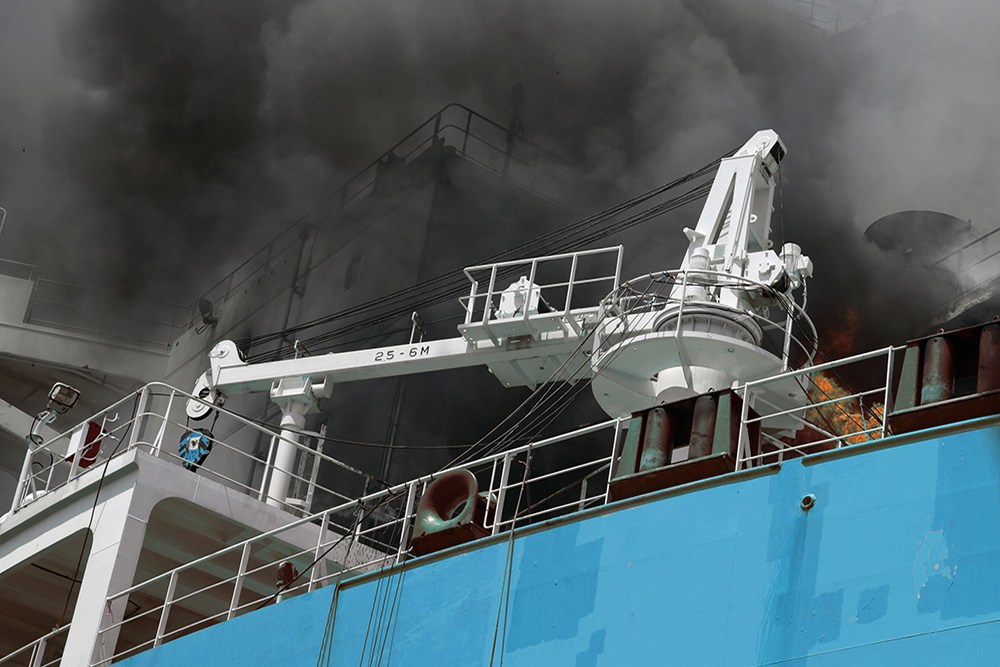Dangerous Goods – The Cause Of Fatal Ship Fire?

A report by Singapore’s Transport Safety Investigation Bureau has concluded that the deadly fire aboard the containership ‘Maersk Honam’ in 2018, may well have been caused by dangerous goods.
While they could not conclusively determine the cause, the report ruled out other likely sources. This had led to the view that a giant block stow of an oxidizing compound, called sodium dichloroisocyanurate dihydrate (SDID), was the cause of the fire, the loss of four lives and led to multi million pound ship being scrapped.
SDID is classified as Class 9 miscellaneous dangerous goods and not the more dangerous Class 5.1 oxidizer. However, it is highly oxidizing and has the potential for self-decomposition when stowed in bulk, which has led to a recommendation to reclassify the product.
When the vessel set sail in March 2018, 1,000 tonnes of SDID was stowed in a stack of 54 containers in one of her holds – the hold where the fire broke out. The stow was fully compliant at the time and therefore no safety issues were detected.
At 19:45 on March 6th, while in transit off the coast of Oman, a smoke alarm went off in the above mentioned hold. The report outlines that the ship’s master smelt chlorine as he headed for the bridge, but saw no smoke. 6 minutes later, the fire alarm was sounded and crew members gathered for a response.
Two firefighting teams managed to shut off most of the vents around the hatch to the hold, but they could not seal off ventilation flaps on the port side. Despite this, the master ordered the use of the CO2 flooding system in an attempt to extinguish the blaze. The third and final use of the CO2 was followed by several explosions and a large plume of smoke, which engulfed the accommodations block and led to panic.
The crew abandoned ship and of the 23 survivors rescued by another nearby vessel, one crew member died of injuries before reaching the shore. During the rescue and salvage operations, the bodies of two more crew members were discovered and one crew member has never been found.
The survivors reported that during the firefighting they encountered “white colored smoke with a strong bleach or chemical smell,” and were experiencing breathing difficulties and skin irritation. A blue uniform recovered from the ship was almost white, and nearby firefighting gear showed extensive bleach discoloration.
While not conclusively determining the dangerous goods as the cause, the investigators have noted that the crew’s testimonies are consistent with exposure to the decomposition of SDID, which produces white smoke and chlorine gas when overheating.
Follow Us
Stay up to date with our news and articles on social media
Contact Us
Tel 01675 466521
Email
sales@dangerousgoodspacking.com
Dangerous Goods Logistics
Dangerous Goods Compliance
Related Articles
Dogs That Can Detect Lithium Batteries
The detection of lithium batteries using dogs is being pioneered in France, and is expected to roll out globally following a successful six-month trial.
Felixstowe & Liverpool Strike Update
Workers at the Port of Felixstowe are due to start an eight day strike starting from this weekend and now Liverpool dock workers have voted for industrial action too.
New Lithium Battery Rules For Air Cargo
From 1st April 2022, new IATA regulations have once again been introduced for the movement of lithium batteries by air. These changes were buried in the IATA DG Regulations.




